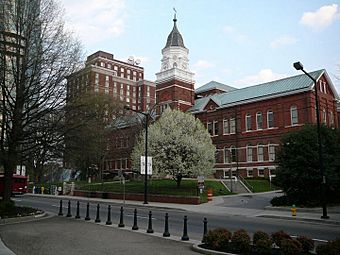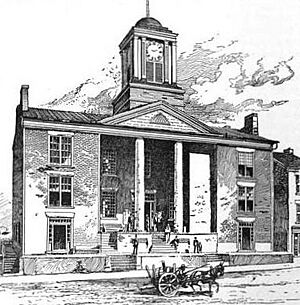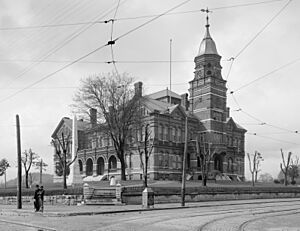Knox County Courthouse (Tennessee) facts for kids
Quick facts for kids |
|
|
Knox County Courthouse
|
|

Old Knox County Courthouse
|
|
| Location | Knoxville, Tennessee |
|---|---|
| Built | 1886, additions 1919 |
| NRHP reference No. | 73001803 |
| Added to NRHP | April 24, 1973 |
The Knox County Courthouse is an old and important building in Knoxville, Tennessee. It was built in 1886. For many years, it was the main courthouse for Knox County. Even though a new building opened in 1980, this historic courthouse still holds many county offices. John Sevier, who was Tennessee's very first governor, is buried right on the courthouse lawn. This building is special because of its design and its part in the county's history.
Contents
Building Design and Style
The Knox County Courthouse is a two-and-a-half-story building made of brick. It has a tall clock tower that stands out. The building mixes different styles of architecture. You can see Colonial parts in the clock tower. It also has Gothic elements, like cool patterns called quatrefoils, on its balcony and porch. Many parts of the inside have been changed over the years.
A Look at the Courthouse's History
The land where the Knox County Courthouse stands today was once Lot 36. This was part of the original plan for Knoxville from 1791. The lot across the street was meant for the county's first courthouse.
The First Courthouses
The very first courthouse for Knox County was finished around 1793. People didn't like how it looked. One story says a "frolicsome Irishman" burned it down a few years later. Everyone in the city was happy about that! The spot where the current courthouse is now used to have a federal blockhouse. This was a strong building for defense.
Knox County's second courthouse was built around 1797. This building was even mentioned in a short story by George Washington Harris. He described it as an "old stone Court-house" with a "steep gable front." By the 1830s, this courthouse was falling apart. Local leaders wanted a new one.
Construction for the third Knox County Courthouse started in 1839. It was finished in 1842. This building had a Federal-style look with some Greek Revival parts. It was built by John Dameron and Drury P. Armstrong.
Building the Current Courthouse
Work on the fourth, and current, Knox County Courthouse began in 1884. The county bought the land across from the third courthouse. This spot used to have a big hotel called the Mansion House. A local company, Stephenson and Getaz, was hired to build the courthouse. They used designs from a New York company.
This new courthouse cost $82,000.00. It was built to be fireproof and included a huge 2,500-pound bell. In 1919, more sections were added to the east and west sides of the building.
In 1980, the county's main court and government offices moved to a new building. There was talk of tearing down the old courthouse. But a group led by Dwight Kessel worked hard to save it. The building is still used today for several county offices, like the county clerk's office.
Important Monuments and Markers
Many monuments stand on the courthouse grounds. They tell stories about important people and events in Tennessee's history.
Honoring Governor John Sevier
Tennessee's first governor, John Sevier (1745–1815), died in Alabama. In 1889, his body was brought back to Knoxville. He was reburied on the lawn of the Knox County Courthouse. A monument was placed on his grave in 1893. Later, in 1922, his second wife, Catherine "Bonny Kate" Sherrill Sevier, was also buried next to him. In 1946, a family member placed a marker for Sevier's first wife, Sarah Hawkins.
Other Historical Markers
Other monuments include a marble arch for Dr. John Mason Boyd. This arch faces the Gay Street and Main Street intersection. There are also stone monuments that mark the site of the old 1790s federal blockhouse. Another marker celebrates Knoxville as the first capital of Tennessee. One monument remembers the signing of the Treaty of Holston in 1791. There's also a stone monument for the county's veterans from the Spanish–American War. Two Tennessee Historical Commission markers also tell about the Treaty of the Holston and the third courthouse.
Images for kids
-
The Spanish-American War Monument (left) and the grave of John Sevier (center).






